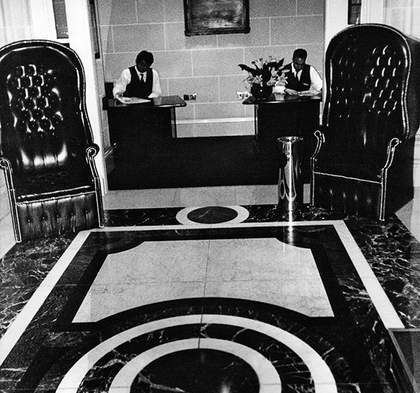
Sir William Rothenstein
The Doll's House 1899-1900
Oil on canvas, 889 x 610 mm
There are two great slashes of deep dark black that cut across the wonderful vertical picture plane of William Rothenstein’s obscure painting The Doll’s House. It is an amorphous blackness in which you could imagine yourself losing everything – your position in society, your security, your entitlement… your soul.
In the picture we see a couple at the bottom of a staircase. A woman sits on the stairs conforming to the pictorial signs of the ‘fallen woman’. She averts her face from the (male) gaze of the viewer, unlike our male figure who stares at us – challenging our interpretation of this scene. I say male gaze in the way that the feminist film theorist Laura Mulvey might, but this is a Victorian painting. And at the time it was created, the woman depicted was, I imagine, a prostitute.
Our seducer, with his cape draped over his arm, produces a contrast in stereotypes. His attractiveness to the woman is based on his opposition to the decent Victorian middle-class notions of self-denial and duty: the moral authority and power relationship that subjugated and regulated women’s behaviour within the domestic sphere of a nuclear bourgeois family – heavily established in her mind by the husband or a father. He is the sexy ‘other’.
…
You are about to run away, about to find out who you really are, to find out if you can survive at the bottom of a staircase – where it meets the street and economic reality, because it’s all about money and protection. And you’re going to have to live without it now. But guess what. You might find yourself. Your real self. Escape from that husband, from that family, from those children!
While waiting for the carriage, you have a moment of panic; second thoughts about leaving your secure but suffocating life. You are now staring into the unknown, while beside you stands the seducer and his ominous shadow. This shadow is a huge black hole of metaphysical vomit; it is the heart of the darkness of the man’s clothing.

Chris Shaw
Two Ordinary Night Porters from the series Life as a Night Porter c.2000
Gelatin silver print on paper, 400 x 300 cm
© Chris Shaw, courtesy the artist, Tate collection
This is a timeless scene. You can see it in modern London nightlife. You can see it (as I have) in the early hours in hotel lobbies and in the foyers of night clubs. These great social sexual dramas are played out in modern-day courtships – the one-night stand replacing the permanent fall from grace. Have times changed that much? We are still heavily bound within strict class codes. Step outside our class system for love and we are surely doomed, are we not? The staircase goes up as well as down. Sin does not equal a lifetime of suffering and death, but the choice is still there. We can run away with snake charmers; we can elope with hashish-smoking gypsy tarot card readers, and we can still bankrupt ourselves for love. This is all there in this painting.
Of course this is my fictional narrative, but great works of art have a life of their own. The official story about this painting refers to Henrik Ibsen’s 1879 play A Doll’s House, in which the protagonist Nora leaves her husband and children to discover herself. Apparently, the man you see posing in the picture is Augustus John, but who cares about all that when we have our own imagination?

